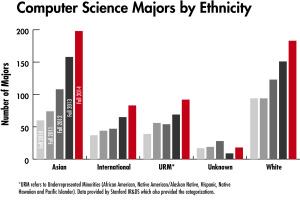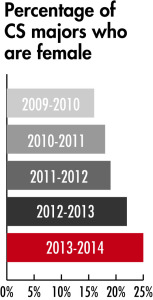Back in high school, Khalil Griffin ’15 didn’t feel comfortable taking computer science classes.
“In high school I stereotyped myself out of CS,” Griffin said. “Everyone else in the class was white.”
At Stanford, Griffin gave CS another shot and majored in it. Yet he still recognized a lack of racial diversity among his peers and professors in CS classes.
In the first few weeks of last quarter, Griffin spoke to his major advisor, Stephen Cooper, about his concerns.
Now Griffin and five other CS majors are getting ready to attend the 2015 ACM Richard Tapia Celebration of Diversity in Computing Conference next month in Boston, with all expenses paid by the School of Engineering.

While Stanford representatives have attended the national diversity conference before, this year marks the first time Stanford serves as a platinum supporter, having contributed $8,000 to the event, according to Valerie Taylor, executive director of the national Center for Minorities and People with Disabilities in Information Technology.
The investment in the conference is just one example of the CS department’s latest collaboration with students to address and support ethnic diversity among the CS undergraduate population — a recent effort the department is turning its attention to, according to Cooper, an associate professor of CS.
“We realized we need to do more so we’re becoming very aggressive in trying to support our students,” Cooper said.
A feeling of isolation
While students largely agreed that the ethnic diversity of CS majors at Stanford fares much better than at peer institutions, they recognized that there’s still work to be done to create a more welcoming environment for underrepresented minorities in the department.
When Pablo Hernandez ’17 took CS 106X: Programming Abstractions his freshman year, he quickly made an unsettling realization.
“I’m sitting in this room and I realized I’m like one of four Latinos in this class and that’s a huge problem,” Hernandez said.
Jordan Miller ’15, president of Stanford’s Society of Black Students and Engineers (SBSE), said that the issue of stereotype threat for underrepresented minorities and the feeling of not belonging in CS because few others in class look like you are still prevalent problems at Stanford.
Taylor, a leading speaker on the importance of diversity in computing, said that the feeling of isolation among minority students in CS leads to a retention issue where fewer students of color choose to stay in computing fields. This in turn adds to a pipeline issue where there aren’t enough racially diverse CS Ph.D.s to be professors and serve as mentors to future students.
Keith Schwarz ’10 M.S. ’11, a lecturer in CS, recognizes various stereotypes that exist about what computer science is about and who does it, which can turn several people away from the field.
“With computer science it’s very easy to get people to bounce right off it,” Schwarz said. “You can make the stuff arbitrarily uninteresting.”
A collaborative solution

When Griffin approached his advisor last quarter with concerns about the lack of ethnic diversity in CS at Stanford, he learned that it took student initiative in drawing faculty’s attention to the issue to get things rolling.
Cooper noted that a similar strategy is what led to the collaborative efforts over the last few years in addressing the lack of women in CS.
Students brought the gender gap issue to the attention of faculty, which led to the creation of women in CS student groups.
Tara Balakrishnan ’16, co-president of Women in Computer Science, said that the CS department now serves as support for the student-led programs on women in CS by offering funds to help put on events and announcing group events in introductory classes.
Schwarz, who said he started getting involved in efforts to support women in CS after learning about the issue through his students, realized this past summer that the department hadn’t done a lot of outreach to other diversity groups.
After contacting SBSE, the Stanford Society of Latino Engineers (SOLE) and other groups, he soon learned that students were coming together to start their own initiative to address ethnic diversity in CS: DiversityBase.
The initiative, which is in its beginning stages, brings together CS majors from the various ethnic engineering societies on campus to form a network of peer mentors for underclassmen and a friendly community within the CS field, according to Jorge Aguirre ’15, co-vice president of SOLE and one of the student leaders of DiversityBase.
“The CS department is really excited about this; they want to push it, but they need our energy and the way we’re a lot closer to the student body,” Aguirre added.
While Schwarz looks forward to the initiative’s role in addressing concerns of underrepresented minorities in CS, he and students also recognize that the CS department can still contribute to the cause in their own way.
“We can only do so much as an organization,” Miller said of SBSE’s efforts to create a welcoming environment for its CS members.
One concern Miller said that certain black CS majors face in lectures is that they are unable to resonate with the presented material because they want to find ways to use the skills they learn in class to be able to give back to their communities, rather than find ways to just make money in Silicon Valley.
“Opening up the possibilities of what you can do with a CS degree and an engineering degree really resonates with our community,” Miller said.
To address this concern, Schwarz likes to present examples in his introductory class lectures of what CS looks like in a way that defies the stereotypes.
One such example is how mobile app development is big for communication systems that would allow for texting in Kenya, where mobile technology is a much more prevalent topic.
“We’ve done bits and pieces. We can do more,” Schwarz said of the CS department’s efforts to address issues of ethnic diversity.
Long-term benefits
With the field of computing now ubiquitous in society, Taylor, whom the CS department invited to speak on campus in spring, said that the demographics of the field must align with society’s demographics as a whole.
Whether it’s through student-initiated programs or the CS department’s own investment of resources, CS faculty and students recognize the long-term benefits of increasing ethnic diversity in CS both on and off campus.
Schwarz said that one tactical benefit that comes with an increase in ethnic diversity, and even gender diversity, is that members of underrepresented communities can better address problems prevalent specifically to these groups.
“I think it’s important for people from all backgrounds to have access to this sort of technology…to create the solutions because it enables them to solve important pressing problems that don’t normally get a lot of attention,” Schwarz said.
Others like Griffin — who hopes to bring back diversity strategies from the upcoming conference that he can apply to Stanford — said that diverse voices would contribute fresh new perspectives to the field of computer science otherwise lost.
While students and faculty agreed that there is still much to be done by both parties to fully address diversity concerns in the department and the field of CS overall, work towards a solution is underway.
“Everyone really does seem to care about this and it’s just a question of how best to do it,” Schwarz said.
Contact Ileana Najarro at inajarro ‘at’ stanford.edu.
